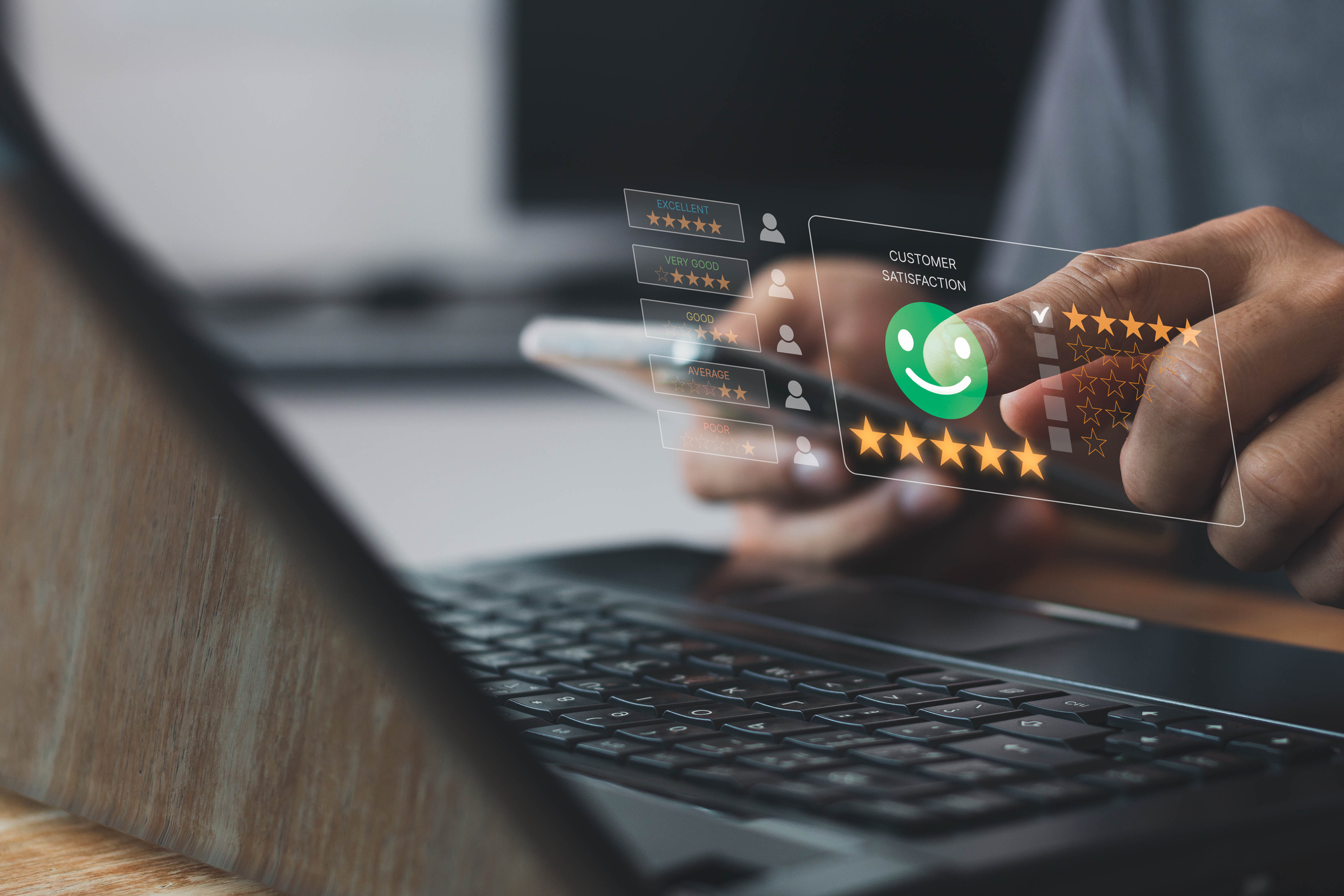B2B Customer Experience: The Complete Guide

Managing the B2B customer experience is a key growth strategy for organizations across a wide variety of industries. For good reason: delivering great customer experience (CX) leads to increased loyalty, lower churn, more referrals, positive word of mouth, and higher-value customers.
B2B (business-to-business) transactions often involve ongoing relationships and partnerships. Effective customer experience management helps build and maintain strong, long-term relationships by meeting the needs and expectations of your business customers consistently.
What is B2B Customer Experience?
B2B customer experience can refer to the interactions and overall relationship between a business and its business customers. It may also refer to a digital benchmark: your customers’ interactions on your website, mobile app, or software dashboard. The B2B CX may also refer to a company’s ability to respond to customer questions and cases.
Given these various interpretations, we can define the B2B customer experience as the cumulative impact of all interactions and experiences between your business and your business customers, at every touch point across the entire customer journey.
Why is B2B CX Important?
The B2B customer experience is a crucial aspect of building and maintaining successful and long-lasting relationships in the business world. Organizations that strategically allocate their resources to strengthen their customer experience focus stand to gain an edge over the competition.
- Great customer experiences foster loyalty. B2B customers are more likely to continue doing business with a company that consistently delivers value, meets their expectations, and provides excellent service. Loyal customers are also more likely to recommend the business to others.
- Great customer experiences help your brand achieve differentiation. In competitive B2B markets, where products and services may be similar, customer experience becomes a key differentiator. A great customer experience can set your company apart from competitors and help you win and retain clients.
- Great customer experiences bolster your Customer Lifetime Value (CLV). When customers are satisfied and engaged, they are more likely to make repeat purchases, upgrade services, enter into partnerships with your company, and explore additional offerings over time.
- Great customer experiences improve brand reputation. If you consistently deliver positive experiences, your brand is more likely to be seen as reliable, trustworthy, and customer-centric. This positive reputation can attract new customers and partners.
Ultimately, a positive B2B customer experience contributes to customer satisfaction, loyalty, and the potential for long-term partnerships and repeat business. It goes beyond individual transactions and focuses on building a strong foundation for ongoing collaboration.
What are Some B2B Customer Experience Examples?
Here are some examples of how B2B companies are applying tactics designed to improve the customer experience:
- CRM platform HubSpot utilizes chatbots to connect with customers and encourage open communication. The chatbots automatically help users find responses to their questions and discover helpful content like help center articles, blogs, and resource pages.
- Social media marketing platform Hootsuite leverages InMoment to make the Net Promoter Score (NPS) methodology central to its operation. By utilizing the in-app customer feedback software tool, Hootsuite can prioritize CX improvements that will have the most business impact and has been able to triple its Net Promoter Score.
- Transport and business services brand FedEx launched a single external newsletter to streamline its communication with customers, instead of sending out multiple emails from various departments within the organization. This helped break down silos and made things simpler not only for FedEx’s customers, but also for each of the company’s internal teams working together to deliver meaningful information and valuable content to customers.
- Software company PandaDoc uses multiple surveys to monitor customer sentiment and improve product experience. The company also acts on insights from customer feedback in order to understand improve the skills of its support agents, enabling them to become better at serving PandaDoc customers.
- Every time a customer buys its cloud storage suite, tech company IBM assigns specialists to help with onboarding and setup. This gives customers a hassle-free experience at a critical stage of their purchase journey. Additionally, IBM specialists educate customers with tutorials, expert advice, recommendations, and best practices to foster long-lasting relationships.
- High-tech industrial company GE operates customer experience centers to showcase the company’s capabilities. Customers can visit these centers to see GE’s manufacturing systems in action and discuss a personalized plan with the company’s CX representatives.
How Does the B2B Customer Experience Differ from B2C?
B2B CX strategies are often inspired by best practices in B2C customer experience management. However, there are key differences and nuances between the two due to the nature of the relationships, the complexity of transactions, and the unique needs of each type of customer.
- Decision-making: B2B transactions are often characterized by a more complex decision-making process involving a group of decision-makers within the business, and the sales cycle may be longer. Relationship-building and addressing the needs of multiple stakeholders are crucial in B2B interactions.
- Customer relationships. In B2B transactions, business customers often seek long-term partnerships, and the relationship extends beyond individual transactions. Personalized service, understanding the client’s business, and collaboration are key elements.
- Customization and personalization. Unlike B2C products and services, B2B offerings usually present various options for customization and personalization in order to meet the particular needs of the business customer.
- Support and service. B2C customer support often focuses on scalable solutions, such as online chat, email support, or call centers, to address the needs of a larger customer base. In B2B, customer support tends to be more hands-on and personalized, with dedicated account managers, CX representatives, and specialized support teams.
How Has the B2B Customer Experience Evolved?
The evolution of B2B customer experience has been influenced by various factors, including advancements in technology, changes in buyer behavior, and shifts in business practices. Here are some stats that reflect some of the ways CX has changed for B2B brands today.
- B2B companies that offer a customized eCommerce experience tend to outsell their competitors by 30%.
- Mobile ordering in the B2B sector has surged by 250% since the COVID-19 pandemic, highlighting a notable transformation in digital practices within the realm of professional procurement and purchasing.
- 100% of B2B customers want self-service options for at least some parts of the buying process.
- Buyers increasingly look to B2B companies as thought leaders and strategic partners, with 84% of B2B executives saying it is very important to lean into their new positions as trusted thought leaders.
- 52% of B2B buyers say the buying cycle for new purchases has gotten longer, proving that the B2B customer experience journey is more non-linear than ever.
B2B CX continues to change as companies adapt to new technologies and expectations. Successful B2B companies recognize the importance of staying agile, customer-centric, and responsive to emerging trends in order to maintain a competitive edge in the marketplace.
How to Improve the B2B Customer Experience: Best Practices
Improving the B2B customer experience involves a combination of strategic planning, effective communication, and a customer-centric approach. Here are some best practices to improve B2B CX.
Create an Integrated CX Approach
In the B2B world, customers use a wide variety of channels to interact with your brand. However, the data most companies collect stays in those channels, and it is analyzed independently of the broader experience.
To improve customer experience, your organization must adopt an integrated CX approach so that you can unlock valuable insights from all sources of customer data, then take action and drive measurable outcomes for your customers. This means collecting and connecting CX data from every touchpoint and channel for a complete view of the B2B customer journey, then navigating and interpreting that data to understand where to focus for the highest impact for your customer and for your business.
Collect Customer Feedback
Invest time in understanding the unique needs and pain points of your B2B customers. Conduct surveys, interviews, and regular feedback sessions to gather insights into their challenges and expectations.
Using information from unsolicited feedback, companies can gain valuable insights into how to improve their brand, products, services, and overall customer experience. B2B companies that are able to monitor and manage customer feedback also often have a more complete understanding of their customers, and can easily measure customer satisfaction and loyalty.
Common sources of customer feedback include:
- Customer feedback surveys
- Comment cards
- Emails and phone calls
- Focus group discussions and roundtables
- Online reviews and ratings
- Social media comments
- Customer interviews and business reviews
- User experience and usability tests
The most successful companies listen to and act on feedback in order to understand their customers better and deliver improved customer experiences. The challenge is to move beyond simply collecting data. A number of successful B2B brands today deploy Voice of the Customer programs to ensure they are really hearing their customers and extracting rich, meaningful insights from their feedback.
Map the B2B Customer Journey
A customer journey map is a visualization of each step your customers take — from the moment they encounter your brand to when they make a purchase and how they react afterward. Using a customer journey map can help your company continuously identify and anticipate the needs, motivations, and actions of your customers.
Through customer journey mapping, your organization can construct customers’ decision-making scenarios — and better understand the factors that influence purchase decisions and move sales cycles forward. This then aids your efforts to deliver improved customer experiences, drive more sales, acquire and retain more customers, and improve your business processes.
Offer More Personalized Experiences
In a world where consumers are bombarded by hundreds or even thousands of marketing and sales messages every day, personalization holds the key to standing out and cutting through the noise.
There’s a wide range of personalization tactics, both online and offline, that you can apply to improve the B2B buyer’s customer experience — from customer-specific content and personalized packaging to responsive website design and insight into customers’ order histories.
By increasing personalization in interactions, touchpoints, and engagements, you give customers a sense of identity and can more easily attract their attention that way.
Personalization also serves as a sign of respect for customers’ loyalty and business. It signals that your business is interested in strengthening the relationship by providing relevant suggestions, better service, and more informed support. This is why IBM assigns specialists to help its cloud storage suite customers get set up: not only does it help customers maximize the value of IBM’s products and services; it also drives personalized experiences that resonate with individual organizations.
Ensure Timely Response, Delivery, and Resolution
Great customer service is a major component of great CX. This means ensuring timely response, delivery, and resolution of issues; it means attending to customer needs and solving their specific problems. It’s important to provide responsive customer service through various channels, including email, phone, and live chat. Also, be sure you work closely with customers to address challenges, gather their input, and implement solutions that align with their business objectives.
Maintaining open and proactive communication throughout the customer journey is also a critical aspect of B2B CX management. Keep customers informed about product updates, new features, and relevant industry trends. Clearly communicate pricing, terms, and conditions. Through proactive communication and transparency, you can inspire brand trust and establish a solid foundation for long-term relationships.
Provide Self-Service Options
With research showing that B2B customers want self-service options for parts of the buying process, it’s essential for your organization to explore and invest in self-service technologies.
Just as a person shopping online has a wide range of products and services to choose from, your B2B buyers should also be able to access content, support, scheduling, and purchasing independently, without direct assistance from a representative.
Examples of self-service tools that B2B businesses can use include:
- Customer portals for account management, order history, and invoice tracking
- E-commerce platforms for product catalog, online ordering, secure payment processing
- Knowledge bases and customer support portals for troubleshooting guides, FAQs, ticket submission, case tracking, and self-help resources
- Feedback and survey tools for sharing input on customers’ experiences and gathering insights for improvement
- Collaboration tools for document sharing, project management, and communication channels
- Chatbots for responses to common queries, product recommendations, and product and service guides
Offering self-service tools and options can directly impact customer satisfaction, as well as contribute to operational efficiency, allowing your team to focus on more strategic aspects of your relationship with clients.
Digitize the B2B Journey
B2B buyers demand tools that simplify and streamline the entire buying process — from research and planning, through engagement, to the post-sales phase. This makes it critical to invest in technology that will better engage consumers and make every part of the customer journey pain-free.
You can implement user-friendly online platforms, intuitive interfaces, and streamlined procedures for ordering, invoicing, and payment. Another good example is utilizing digital “track and trace” systems so that clients can see the status of their orders and actions in real time. As you digitize the B2B journey, ensure robust data security measures to instill trust in your B2B customers and help them build confidence in your partnership.
Achieve B2B Customer Experience Excellence with InMoment
Managing the B2B customer experience is not just about individual transactions but about building and sustaining successful, long-term relationships with your customers. With InMoment, you can integrate customer signals across all relevant channels, gain deeper insights into the B2B buyer’s journeys and experiences, and take informed action with the world’s most recommended CX platform.
References
SmartKarrot. “75 Must-Know Customer Experience Statistics to Move Your Business Forward” (https://www.smartkarrot.com/resources/blog/customer-experience-statistics/). Access 1/3/2024.
TrustRadius. “022 B2B Buying Disconnect: The Age of the Self-Serve Buyer” (https://solutions.trustradius.com/vendor-blog/2022-b2b-buying-disconnect-the-age-of-the-self-serve-buyer). Access 1/3/2024.
Edelman. “How B2B Companies are Adapting Customer Engagement Strategies During COVID” (https://www.edelman.com/expertise/business-marketing/how-b2b-companies-are-adapting-covid). Access 1/3/2024.
Korn Ferry. “The 2021 Buyer Preferences Study: Reconnecting with Buyers” (https://www.kornferry.com/content/dam/kornferry-v2/featured-topics/pdf/2021-Buyer-Preferences-Study.pdf). Access 1/3/2024.



